| “Spring fever”(figure sketch, oil on canvas, 24X30) |
| Headed for the slops pile: the prior week’s figure attempt. Promise you won’t let it get around. |

Watch Me Paint: World-Class Art, World-Class Instruction
| “Spring fever”(figure sketch, oil on canvas, 24X30) |
| Headed for the slops pile: the prior week’s figure attempt. Promise you won’t let it get around. |
Every year I seem to get one kid who draws wonderfully. Sometimes, this kid has managed to decode the rules of drawing on his own. More typically, he has studied outside of school. But however he does it, to the casual observer, he appears to have “spontaneously” learned to draw.
In turn, his teachers identify him as talented, and he is a star of his public school art program. Meanwhile, the majority of kids are vaguely encouraged toward self-expression but never challenged to learn the craft of making art. Nobody considers them particularly talented.
As an educational model, that’s bizarre. If we taught math like that, we’d have only one kid a year who mastered calculus. If we taught English like that, we’d be a nation of illiterates.
There is no more a “genius” for art than there is one for math, and it’s a terrible disservice to both students and society to not teach the craft of drawing to all young people.
When I was in school, art instruction was undergoing a sea change. There were some teachers who still taught the technical skill of drawing, but they were being replaced by a generation who emphasized emotional intensity and ideas rather than the nuts and bolts of observation and description. I was fortunate in having superlative draftsmen as teachers, but I’m among the last generation for whom that was a given.
Almost no kids come to my private studio with any experience in observational drawing. They don’t even know there’s a difference between observational drawing and copying photographs. They have never learned the systems of perspective, measurement, and proportion that were drilled into us in an earlier time.
The painting at the top of this page was done by a high school senior. She started studying with me in August, 2011, having had no prior instruction. She is not someone who could teach herself to draw, and hence she wasn’t identified as “talented.” However, she is extremely bright and hardworking. Moreover, she has a story she’s anxious to tell. In five months time, she has gone from not being able to draw at all to being able to paint at this level: not by concentrating on self-expression but by practicing the core disciplines of drawing and painting.
I’m not worried about her future, but she isn’t going to art school because she didn’t have time to develop the chops needed to put together a mature portfolio. But what if she had been taught to draw in elementary school, as I was? How might her life be different?
And what about all the people who never have the chance to learn the skill of drawing? How many potential Manets or Velázquezes have we squandered?
It’s not often you get a model showing up with a black eye, and that’s irresistible to paint. (Before you get worried that she’s the victim of domestic abuse, she’s a dancer and occasionally her face gets in someone else’s way.)
During the interregnum between open painting and figure, I usually set up my palette in a flesh-tone matrix. This is how I’m able to do a credible figure painting in three hours. Today, a number of interruptions stopped me from doing that, and I ended up doing the first hour of painting using pigments scarfed from a student’s palette. On top of that, I’m working huge for a sketch—this canvas is 48X36. So most of this is a rough underpainting, and I’ll be finishing it next week.
Michelle’s shiner, in draft form
A note about this model: she’s a wonderful, adventurous nut, who allows me to wrap her up in Saran Wrap.

Michelle as a shrink wrapped vegetable, 18X24, oil on canvas
This commissioned work is a formal portrait of a mature woman who desired a nude painting reflecting her Central American heritage. The client wanted an impression of the beauty of a woman not matching the cliché of the commercialized American ideal of willowy, leggy and fair female imagery.
The composition features an S-curve created by the background and gold lace mantilla and subtly reinforced by the rim lighting bathing the model’s knees and leg.
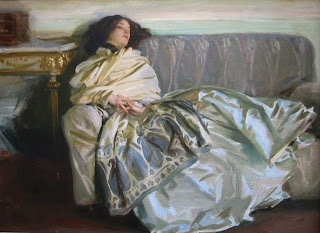
Repose (Nonchaloire), John Singer Sargent, 1911, National Gallery of Art, Washington DC http://jssgallery.org/Paintings/Repose_(Nonchaloire).htm
Again, look at the hands which bring tension into the pose.
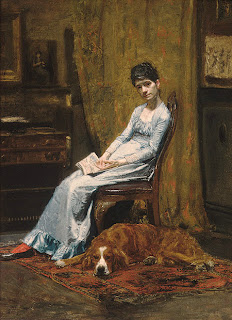
The Artist’s Wife and His Setter Dog, Thomas Eakins ca. 1884–89, Metropolitan Museum of Art
http://www.metmuseum.org/TOAH/hd/eapa/hob_23.139.htm
To me this is the most difficult position to paint. It’s easy to inadvertently make the figure rise in steps like a Ziggurat. That’s especially risky in this situation, where the gown stands so off so intensely from the background. Eakins twisted the torso slightly and further modified the blue shape with the shadows at the front of the skirt and the bodice, creating a lovely, flowing gown.
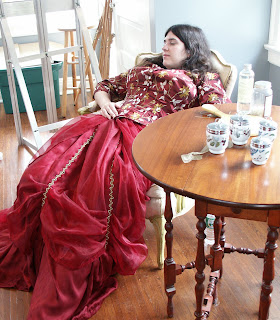 This week’s figure class featured Gail Kellogg Hope modeling a Civil War era gown of her own devising, minus the ruffled hoop. (Readers interested in historic clothing can see Gail’s work here.) Because Gail’s hair was down and she was recumbent, I thought she looked charmingly like a 19th century laudanum addict.
This week’s figure class featured Gail Kellogg Hope modeling a Civil War era gown of her own devising, minus the ruffled hoop. (Readers interested in historic clothing can see Gail’s work here.) Because Gail’s hair was down and she was recumbent, I thought she looked charmingly like a 19th century laudanum addict.
I wanted to begin this essay on languid poses with an American painting, but I was unable to find an American Victorian example. I’m not sure such a painting exists—it would have been contrary to our national myth to see womanhood as anything other than industrious, thrifty, and alert.
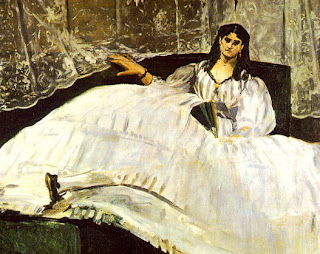 “Baudelaire’s Mistress Reclining,” Edouard Manet, 1862, Szépmüvészeti Museum, Budapest. http://cgfa.dotsrc.org/manet/p-manet35.htm
“Baudelaire’s Mistress Reclining,” Edouard Manet, 1862, Szépmüvészeti Museum, Budapest. http://cgfa.dotsrc.org/manet/p-manet35.htm 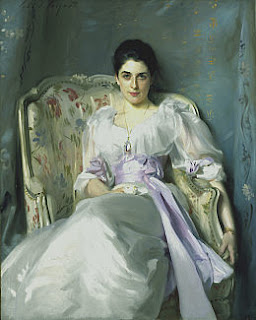
“Lady Agnew of Lochnaw,” 1892-93, oil on canvas, The National Gallery of Scotland http://www.nationalgalleries.org/collection/online_az/4:322/result/0/5396?initial=S&artistId=4829&artistName=John%20Singer%20Sargent&submit=1
The fin de siècle painters were much more comfortable with slouching. I’ve included this example by Sargent largely because the chair resembles the one in my studio—before a century of wear and grime and burst seams. Sargent’s lady reclines, but she is anything but debauched. Instead, the pose is one of aristocratic grace. Although Lady Agnew levels her gaze at the viewer with the same assurance as Jeanne Duval, her chin is down and demure. Notice the right arm culminating in a firm grip—it belies the rest of the pose and points to why Sargent’s portraits are never dull.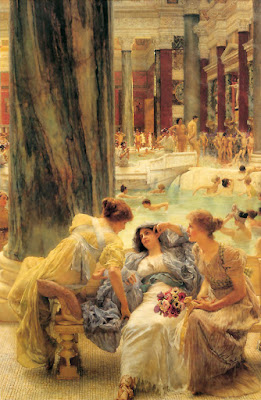
“The Baths of Caracalla,” Sir Lawrence Alma-Tadema, 1899, private collection http://www.artrenewal.org/asp/database/image.asp?id=610
Sir Lawrence Alma-Tadema was proof that not every Dutch painter was brilliant, although he gets my respect for being silly and exuberant. He was, of course, a fine technician. Although not strictly a Pre-Raphaelite painter, he shares with them the tendency to see women as sensual and emotional creatures. In this painting, his Roman matron sinks comfortably into a hard marble bench. Perhaps the background hints that these baths were built by Rome’s most psychotic emperor, but the matron’s couture, coiffure, coloring and companions are strikingly, calmly English. 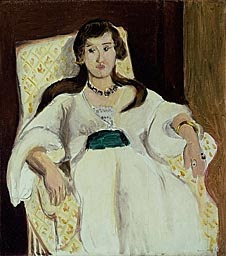
“The Green Sash”, Henri Matisse, 1919, Art Institute of Chicago http://www.artic.edu/aic/collections/citi/object?id=59919&artist=Matisse&keyword=
After that, it is a relief to return to the ambiguity of Matisse. This painting is austere; in fact it has a lot in common with the Manet above. There is no “setting” per se. As in the Manet portrait, the gown has presence and meaning of its own.
Note that in the portrait of Lady Agnew, Sargent is using Matisse’s patterns while in this painting Matisse is using Sargent’s beloved black paint.
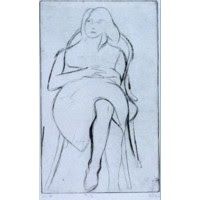
“#13 from the book, 41 Etchings Drypoints,” 1965, Richard Diebenkorn, Fine Arts Museums of San Francisco http://www.thinker.org/imagebase_zoom.asp?rec=6339304212900030
We recognize this last work immediately as a mid-century American drawing by the hemline and the hair. As cloying as that was with Alma-Tadema, it is a virtue in this etching by Richard Diebenkorn. Why is that?
With the hand resting on the abdomen, we have come full circle back to the photo of our model. There seems to be nothing strange about that pose to me, but will future viewers see it as an idiosyncrasy of our age?